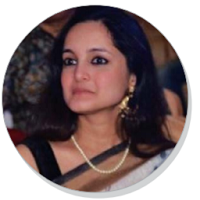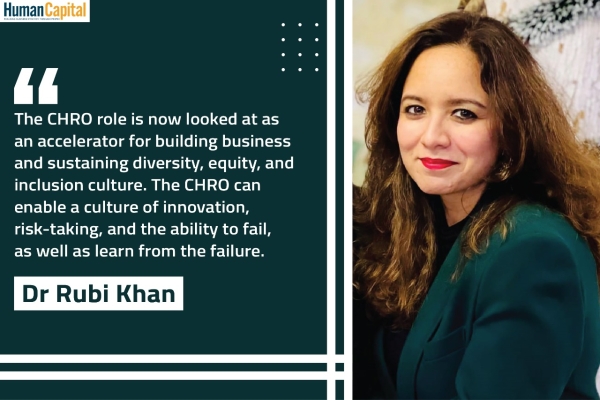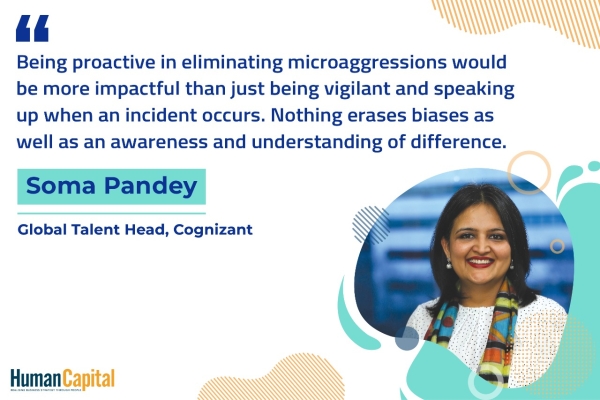Diversity and inclusion are all about engaging the top leaders, getting them to believe, adopt and model the right behaviour so that it trickles down to everyone below them.
An equal world is an enabled world. We are all responsible for our own thoughts and actions. But choosing to challenge stereotypes, fight bias, broaden our perceptions, and celebrate women’s achievements is a conscious decision. Together, we can help create a gender equal world.
This year the theme for the International Women’s Day, which was celebrated on 8th March 2020, was #EachforEqual. But let us take a moment to ponder whether equality is a women’s issue or a business issue.
The business case for Diversity & Inclusion (D&I)
1. Diversity fosters a more creative and innovative workforce. A diverse workforce is better suited to capture a greater share of the consumer market.
2. Recruiting from a diverse pool of candidates means a more qualified workforce which helps businesses avoid employee turnover costs.
3. Research studies increasingly show that D&I can help increase a business’ bottom line, drive innovation, attract more talent, and create more opportunities for growth.
4. Collaborating and engaging through initiatives such as resource groups strengthens team bonds and esprit de corps.
Gender equality is essential for communities to thrive. The race is on for a gender-equal boardroom, a gender-equal government, gender-equal media coverage, gender-equal workplaces, genderequal sports coverage, and better gender equality in health and wealth, but there is a long road ahead of all of us.
How are organisations fostering the D&I agenda?
Most of the early D&I programmes were created to right organisational wrongs such as blatant discriminatory hiring and promotion practices, by focusing on legal compliance. Their notion of promoting diversity was some combination of training seminars, speaker programmes, heritage month celebrations, and parade sponsorships. But as has been proven with time, such an approach almost always fails to generate sustained engagement. D&I efforts must shift from being HR owned to being owned by senior leadership teams. Diversity and inclusion are really about engaging the top leaders, getting them to believe, adopt and model the right behaviour, so that it trickles down to everyone below them.
A refreshing perspective on D&I
Diversity’ and ‘inclusion’ are not just abstract concepts — they are core values and strategic business imperatives that deliver business results. Global Diversity and Inclusion drive businesses by breaking down barriers and changing mindsets so that the powerful potential of employees can be unleashed.
Some classic D&I mistakes:
1. Going for the easy fix.
2. Promising something impossible.
3. Going for best-in-class prematurely.
4. Focusing on representation and not on the pipeline.
A closer look at gender diversity
As per research by SHL, the global leader in Talent Assessment, accelerating gender diversity increases the potential leader talent pool, and women are better prepared to face the most urgent and impactful business challenges. And when it comes to Occupational Personality Questionnaire (OPQ) scores, women surpass men in many dimensions that are positively correlated with performance.
Gender Diversity:Mind the Gap
Typically, women are underrepresented in leadership, partly due to the subconscious bias on what makes an effective leader that emphasise more male-oriented traits. Once you consider the traits associated with success in specific contexts – women are likely to stand out on more success dimensions than men.
Three misconceptions that hinder diversity efforts
1. The playing field is already level
2. Men have innate advantages over women in leadership roles
3. To have more women at the top one needs to hire more women
Are we really measuring our progress on the D&I front?
Diversity and Inclusion Index is designed to measure the relative performance of companies against factors that define diverse and inclusive workplaces. Nowadays, there are multiple companies who benchmark D&I best practices across companies and create an index of diversity.
What works in building an inclusive culture?
◆ A top-down approach is not enough: Top-down approaches drive compliance but not commitment. It is imperative that everyone in the organisation, right from senior leaders to frontline employees, understand their role in creating the company culture. It is critical to identify differences in employee experience and values across the organisation so that the change can be made to be relevant for everyone.
◆ Establish a sense of belonging for everyone: For each individual to bring his or her best self forward, a sense of belonging must first be established. Feeling like a part of the organisational family helps in generating greater engagement and creativity in the workplace.
◆ Forget ‘fit’ and focus on helping individuals thrive: The inequities in society can easily become embedded in an organisation — optimising to hire, train, and reward people who “fit.” Creating a culture where every individual can contribute their full potential requires investigating the systems and processes in an organisation to uncover sore spots and blind spots, and then finding ways to reimagine them.
◆ Quotas do not automate inclusion: Hiring goals may boost diversity numbers, but this will not automatically create an inclusive culture. Very often, leaders focus diversity and inclusion efforts disproportionately on the employee pipeline, but the employee experience continues far beyond an offer letter. To retain and nurture top talent, it is critical to take an honest look at the end-to-end employee experience, with an eye toward creating conditions that promote inclusion on a daily basis and designing ways to measure the impact. Unfortunately, this is a highly ignored aspect of inclusion.
◆ Inclusion is an ongoing activity: It is not enough to merely teach about inclusion and be done with it. Like any form of behaviour change, inclusion requires individuals to identify key moments in which to build new habits or micro-behaviours. And when these habits are put into action in an environment that supports honest conversations and healthy tension, real change becomes possible.
Time to build a gender equal world
#EachforEqual is about ‘Collective Individualism’. We are all parts of a whole and our individual actions, behaviours and mindsets can have an impact on our larger society. Collectively, we can make the change happen. Collectively, we can each help to create a gender equal world. While the change will take time but we all need to choose to be #EachforEqual.
Do you look forward to permanently working from home after the pandemic subsides?
Trending
-
SBI General Insurance Launches Digital Health Campaign
-
CredR Rolls Out 'Life Happens' Leave For Its Employees
-
Meesho Announces 30-Week Gender-Neutral Parental Leave Policy
-
Microsoft Unveils Tech Resilience Curriculum To Foster An Inclusive Future
-
60% Indian Professionals Looking For Job Change Due To COVID: Survey
-
SpringPeople And Siemens Collaborate For Digital Transformation Push
-
86% Professionals Believe Hybrid Work Is Essential For Work Life Balance: Report
-
Almost 1 In Every 3 People's Personal Life Affected Due To Work Stress
-
Meesho Rolls Out Reset And Recharge Policy For Employees
-
80% Of Talent Leaders & Academics Say Pandemic Changed Skill Needs For Youth: Report
-
Hero Electric Rolls Out 'Hero Care' Program For Employees
-
Human Capital In Collaboration With ASSOCHAM Hosts Virtual Conference
-
IKEA India, Tata STRIVE Collaborate To Create Employability And Entrepreneurship Opportunities
-
SAP India, Microsoft Launch Tech Skilling Program for Young Women
-
DXC Technology, NASSCOM Collaborate For Employability Skills Program
-
Lenskart To Hire Over 2000 Employees Across India By 2022
-
Mindtree Launches Learn-and-Earn Program
-
Tata AIA Extends 'Raksha Ka Teeka' To Its Employees
-
Swadesh Behera Is The New CPO Of Titan
-
NetConnect Global Plans To Recruit 5000 Tech Professionals In India
-
Hubhopper Plans To Hire 60% Of Indian Podcasters By 2022
-
Corporate India Needs More Women In Leadership Roles: Report
-
Aon to Invest $30 Million and Create 10,000 Apprenticeships by 2030
-
Tech Mahindra Launches ‘Gift a Career’ Initiative for Upskilling of Youth
-
40% Women Prefer Flexible Working Options in Post-COVID World: Survey
-
3 out of 4 companies believe they can effectively hire employees virtually: Report
-
Vodafone , CGI and NASSCOM Foundation launch digital skills platform
-
Odisha: Bank, postal employees to deliver cash for elderly, differently-abled persons
-
Skill India launches AI-based digital platform for "Skilled Workforce"
-
Hiring activity declines 6.73% in first quarter: Survey
-
70% startups impacted by COVID-19 pandemic
-
Bajaj Allianz Life ropes in Santanu Banerjee as CHRO
-
Over 70 Percent MSMEs look at cutting jobs to sustain businesses
-
93 Per Cent employees stressed about returning to office post-lockdown
-
Johnson & Johnson India announces family benefits for same gender partners
-
Indian firms turning friendly towards working mothers
-
Welspun India names Rajendra Mehta as new CHRO
-
Wipro partners with NASSCOM to launch Future Skills platform



Human Capital is niche media organisation for HR and Corporate. Our aim is to create an outstanding user experience for all our clients, readers, employers and employees through inspiring, industry-leading content pieces in the form of case studies, analysis, expert reports, authored articles and blogs. We cover topics such as talent acquisition, learning and development, diversity and inclusion, leadership, compensation, recruitment and many more.
Subscribe Now













































Comment